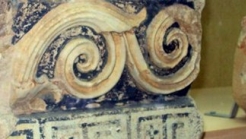

Greece
In Greek culture, food is so much more than sustenance – it’s about culture, comfort, family and life itself.
History
Greek cuisine has a culinary tradition of some 4,000 years and is a part of the history and the culture of Greece. Its flavors change with the season and its geography.Greek cookery, historically a forerunner of Western cuisine, spread its culinary influence - via ancient Rome - throughout Europe and beyond.Many well-known Greek dishes are in fact part of the larger tradition of the food of the Ottoman Empire, with classic dishes such as moussaka,yuvarlakia, keftethes, boureki and tzatziki having Arabic, Persian and Turkish roots.It has influences from the different people's cuisine the Greeks have interacted with over the centuries, as evidenced by several types of sweets and cooked foods.
It was Archestratos in 320 B.C. who wrote the first cookbook in history.
From some of the best lamb dishes on earth to fresh seafood, vegetables, beans, pulses and, of course, good olive oil, Greek food is simple, colourful and incredibly nutritious. Like other Mediterranean cuisines, Greek food has a reputation for being heart healthy with its heavy use of olive oil, fish, lean meats, vegetables, herbs and grain, although some dishes can be quite rich, like the classic moussaka – a hearty dish made of layers of lamb and eggplant, smothered in béchamel sauce and cheese.
Greek cuisine uses some flavorings more often than other Mediterranean cuisines do, namely: oregano, mint, garlic, onion,dill and bay laurel leaves. Other common herbs and spices include basil, thyme and fennel seed. Parsley is also used as a garnish on some dishes. Many Greek recipes, especially in the northern parts of the country, use "sweet" spices in combination with meat, for example cinnamon, whole spice and cloves in stews.
Some dishes can be traced back to ancient Greece: lentil soup, fasolada and pasteli (candy bar with sesame seeds baked with honey) some to the Hellenistic and Roman periods: loukaniko (dried pork sausage) and Byzantium: feta cheese, avgotaraho (cured fish roe) and paximadi (traditional hard bread baked from corn, barley and rye). There are also many ancient and Byzantine dishes which are no longer consumed: porridge as the main staple, fish sauce, and salt water mixed into wine.
Mezes refers to small dishes, which frequently help make up a main meal, served with salads, dips and pita bread. Besides the ever-present olive oil, other widely used ingredients and flavorings include eggplant, tomatoes, potato, okra, lemon, cheese, herbs and honey. Greece's climate favors the breeding of sheep, making beef dishes less common in traditional fare. Many dishes are wrapped in filo pastry - including Greek classics such as spanakopita (spinach and feta) and the honey-drenched, nut filled dessert baklava. As for beverages, strong Greek coffee, retsina (white wine with pine resin added),raki,tsipouro and the 80-percent-proof anise flavoured ouzo are all ever popular.
When Greeks taste something delicious, they have a lovely phrase "Yia Sta Heria Sas" which translates as "Your hands are blessed", celebrating the skill of the cook.
Video


The Acropolis hill was the site for the most important and glamorous temple of the ancient city, dedicated to Athena, the protector godess of the city. This sacred site is connected to the most important myths of ancient Athens, the great religious ceremonies.


The Polygyros Archaeological Museum houses exhibits from all over Chalkidiki.


If you follow the dirt road from Elafonissi, this “hidden” beach will appear behind a rock. Leave your car at the plateau you will find, and walk the downward path, which will lead you after a few minutes to an amazing cedar forest.
1039 Ε 6061 01515 00